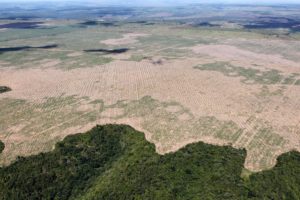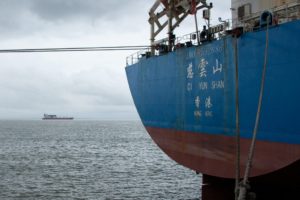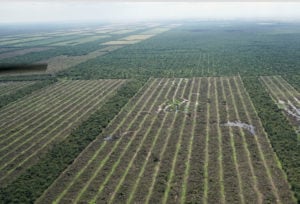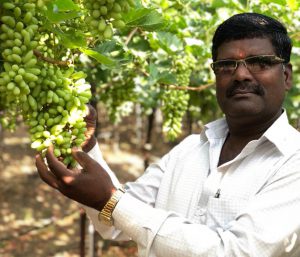Chinese banks have come under fire in recent years for continuing to fund coal-fired power plants overseas despite the unfolding climate crisis. A new report makes the case that Chinese financial institutions should also address a less obvious perpetrator: the soybean.
China is the world’s largest importer of soybeans and in the wake of the trade war it has increased imports from South America. This is expected to drive a new wave of deforestation in South America, imperiling the region’s biodiversity and critical carbon sinks.
The new report by the Carbon Disclosure Project (CDP) reveals the link between Chinese financial institutions and deforestation, via their clients in the soy business.
To date, these institutions lag behind international best practice in addressing deforestation. But CDP argues that they can play a key role in pushing for sustainability in the sector going forward.
So can banks in Beijing prevent deforestation in South America?
Cutting trees to grow soy
China’s soy imports were associated with 49,000 hectares of ‘deforestation risk’ in 2017, according to the watchdog Trase. This represents 46% of all the area in Brazil at risk of deforestation because of soy.
The rate of deforestation is expected to rise as China looks to Brazil to replace its soy trade with the US. Brazil was previously China’s second largest source. According to the CDP report, to make up for the US shortfall, Brazil would have to deforest 25 to 57 times the amount it did to meet Chinese demand from 2013 to 2017.
This trend is significant from a climate change perspective because Brazil is the world’s sixth largest emitter of greenhouse gases. One half of its emissions come from deforestation. The report states that agriculture is the main driver of deforestation, and soy cultivation is one of the main culprits.
To make up for the US shortfall, Brazil would have to deforest 25 to 57 times the amount it did to meet Chinese demand from 2013 to 2017.
Deforestation risks
CDP argues that the environmental impact of soy cultivation presents risks for both Chinese companies buying the beans and the institutions financing them. Global calls to address deforestation are putting pressure on banks and companies and could affect their business.
The Paris Agreement included forest conservation and restoration as one of its key goals because 10-15% of all greenhouse gas emissions come from forest degradation or loss.
The UN Sustainable Development Goals also aim to stop deforestation and restore degraded forests globally by 2030.
10-15%
of all greenhouse gas emissions come from forest degradation or loss
In response to this global call, efforts have been made to prevent deforestation. In 2018, 50 investors managing over US$5.6 trillion in assets formed a coalition with companies to push for zero deforestation in Brazil’s Cerrado region.
As these efforts increase alongside national government regulation and direct climate impacts, companies are being pushed to decrease operations in areas of high deforestation risk. In CDP’s 2017 survey, 32% of responding companies reported having already experienced detrimental impacts associated with the production or consumption of forest-risk commodities, including soy.
To the extent to which companies are affected by these risks and changes, their financiers are also affected. According to the report, 34% of the Chinese financial institutions’ loans to the sector – at least US$2.1 billion – are exposed to deforestation risks. A few major Chinese banks provide the bulk of loans to the sector, with Bank of China at the top supplying 32%.
Addressing deforestation
So far, these banks have not developed any policies to address deforestation, the report finds. Only eight of the institutions analysed take environmental factors into account in their decisions, and those that do focus on screening key polluters as defined by the Ministry of Ecology and Environment, not on deforestation.
Although Chinese banks are not currently aware of their exposure to risk or taking action, CDP makes the case that they could influence their clients to take action.
Some financial institutions outside of China have already been putting this theory to the test. HSBC requires customers to acquire certifications of global zero-deforestation from the Roundtable on Responsible Soy Association (RTRS) and will discontinue business in the case of non-compliance. JP Morgan Chase & Co requires the same.
Based on our research and interviews, shareholders (institutional investors) are in a better position to engage soy companies
While good on paper, these policies have limited effect, according to Isabel Nepstad, program manager for Solidaridad’s China Sustainable Commodity Trade Program. “It is really hard for them alone to push this on their clients because it is very easy for the Chinese company to switch and go to another bank, especially a Chinese bank that doesn’t have these policies,” she said.
However, if more banks were to join together in adopting these policies, they may have more influence.
The CDP report recommends that Chinese financial institutions first assess their deforestation risk exposure, including requesting data from client companies on their soy supply chains, and then formulate policy responses as international banks have done.
They recommend that banks prioritise client companies active in high deforestation risk sectors and incentivise them to eliminate deforestation from their supply chains.
Chinese shareholders can also play a role as they currently have higher exposure to deforestation risk than banks.
“Based on our research and interviews, shareholders (institutional investors) are in a better position to engage soy companies […] They also have considerable influence on portfolio companies,” Sabrina Zhang, the director of CDP China said.
“Some institutional investors in China who are seeking a presence in international capital markets are also motivated to increase their sustainable investment.”

Role for governments
Whether financial institutions have enough of an incentive to take action in the short term depends on how acutely they feel risks. So far, Nepstad says, “They don’t see the risks and it isn’t directly impacting them.” Regulatory and corporate action to address deforestation is on the rise, but most companies are still pursuing short-term thinking about their bottom lines.
Deforestation changes rainfall patterns, which has already led to R$17 billion (US$4.4 billion) in crop losses in Brazil. Droughts and rainstorms are harbingers of climate impacts to come, but since companies grow soy globally, they are able to weather short-term regional supply fluctuations, according to Nepstad.
Nepstad says governmental action is needed to push companies and financial institutions forward. Regulatory efforts may increase in years to come, bringing the urgency of the issue to the fore and requiring financial institutions and companies to act.
Ahead of the biodiversity COP to be held in Kunming, China in 2020, countries have begun discussing ways to address deforestation linked to agriculture such as soy cultivation.
Zhang said:
“If the Chinese government starts to advocate, regulate and develop guidelines for sustainable agricultural supply chains, and starts to ask financial institutions to incorporate deforestation considerations into their financial decisions, that would provide a strong driving force for both companies and financial institutions to implement changes in line with the government.”








